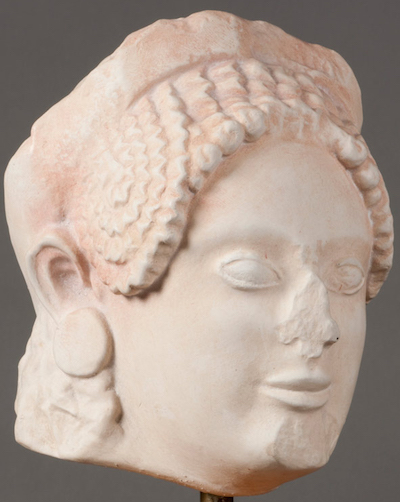All of the casts in the Logie collection are tinted in a light pinkish hue, and some have ‘replicated’ paint traces to imitate those that appear on the original. Tinting serves a practical function of making the features of the face and hair more visible than they would otherwise be if the plaster was left with its normal stark white colour. In the case of the casts in this collection, the tinting was added after the original cast was made, as is apparent from chips and breaks that occurred on some casts as a result of the 2010 Christchurch earthquake.

Colour and Casts

A cast in the Logie Collection showing the pink tint clearly applied to the plaster. JLMC CC11, James Logie Memorial Collection
We know that stone sculpture was painted in Antiquity, so whatever the reason for tinting modern casts, there is certainly a precedent for painted originals. Paint traces visible to the naked eye remain on a significant number of ancient works, and scientific analytical techniques are able to identify many more microscopic paint traces and the chemical residue of paint. Many museums have created painted replicas of specific works in order to give modern viewers a better impression of how sculpture looked in Antiquity. Hair and skin were painted, and it is likely that mens’ skin was shown as darker than womens’ because men spent more time outdoors. Details of the lips and eyes (the colour of the iris and pupil, as well as brows and lashes) were also added. Clothing was painted, as well as military uniforms and equipment. In battle scenes, blood emitted from the wounds (and in some cases ‘real’ spears protruded). It is possible that relief scenes had details of landscape or surroundings added in paint to the back surface.
Our knowledge that ancient freestanding and relief sculpture was painted requires us to rethink ancient sculpture, and to consider what we are missing, and how those now-invisible details that were added in paint might contribute to the message of the work, the identification of specific figures, and our understanding as viewers.